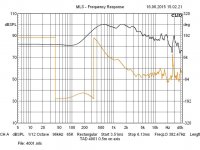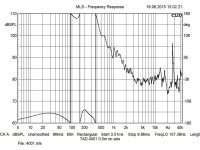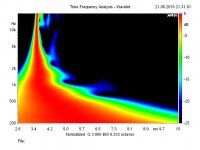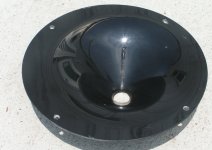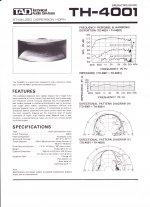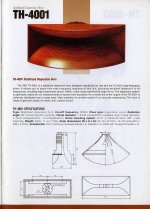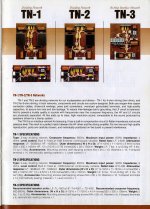Thanks, I only hope to inspire by showing what is possible if you puts in some effort.
Glad to reade you like the multicellular horns Pano, the Altec 1505 sounded more open but also more rough arond the edges. It also sounded better above 4k than mine did. However, mine lacked coloration and own caracter.
I'm not that active anymore, three little kids, house, wife and work consumes a lot of time. Better to see what you guys are doing for the diy community for a while until I'm back...
Glad to reade you like the multicellular horns Pano, the Altec 1505 sounded more open but also more rough arond the edges. It also sounded better above 4k than mine did. However, mine lacked coloration and own caracter.
I'm not that active anymore, three little kids, house, wife and work consumes a lot of time. Better to see what you guys are doing for the diy community for a while until I'm back...
Hi Petter, thanks for joining in.
Like many members of this forum I was impressed with your craftsmanship.
Those multicells were truly stunning.
Are you still using (DIY) horns today?
Real DIYers have multiple subs, don't you know 😉
This has been sticking in my mind for no reason at all. Here, Allen is subliminally suggesting that I design two sets of PPSL using 4 dayton Ultimax 18's.
I think that I have found the right horn for camplo and his size restrictions. If I remember well the exponential horn has a terminated mouth and it is terminated at 45 deg. For this angle the reflecting waves from mouth to throat from it's real and imaginary part should theoretically cancel. Therefore, this is a horn of this type derives from spherical wave horn with T=0.7. the length s about 90cm:
View attachment 795090 View attachment 795091
View attachment 795092
Is it possible for this to have a roll over?
Is it possible for this to have a roll over?
This was a special programming inside my code to have something similar to the optimal exponential horn. A roll-back may harm more than it helps here. If you prefer a roll-back then stick with the version I already posted earlier.
When I wanted to approach things from the other side of the spectrum, going completely wide dispersion, couldn't I just run the drivers without a horn and raise the crossover? Someone once made the comment that the best tweeter they heard outside of a horn was a compression driver without a horn.
There are two interrelated concepts in a wave - particle velocity and pressure. Their value corresponds to the energy created by the diaphragm.
In a hypothetical, generic, solid horn their value is constant as the wave moves from the "throat" to the "mouth"
The ear hears velocity and, accordingly, amplitude, because one is the derivative of the other, v = dx / dt.
The driver produces a wave with high pressure, but with a small amplitude (velocity), as it moves from the "throat" to the "mouth" of the horn, the horn's expansion provides space to the particles inside the wave, as a result pressure drops, amplitude (velocity) increases.
Accordingly, the horn should expand until the pressure inside the wave decreases equal to the pressure of free space, then the wave (without reflection) leaves the mouth and continues to move in free space, having a low pressure but a large amplitude (particle velocity).
Thus, a horn is a transformer, just like an amplifier transformer, except as regards amplifiers we are talking about the product of voltage and current, and in a horn - pressure and amplitude.
Wrt amplifiers we are talking about matching the speaker's resistance, as for a horn it's about matching the pressure of free space.
Using the driver without a horn is a bit like connecting an 8-ohm speaker directly to a tube's anode and trying to hear something.
Last edited:
Attached: TAD TH4001 horn with 4001 driver.
Fc is 290Hz.
The hyperbolic horn begins to "work" about 0.5 octave above Fc, i.e. 400Hz
In the frequency response plot, the frequency at which the horn loses its effectiveness is clearly visible - 3500 Hz.
400Hz plus three octaves is 3200Hz.
Fc is 290Hz.
The hyperbolic horn begins to "work" about 0.5 octave above Fc, i.e. 400Hz
In the frequency response plot, the frequency at which the horn loses its effectiveness is clearly visible - 3500 Hz.
400Hz plus three octaves is 3200Hz.
Attachments
Last edited:
The Fc of the TH4001 specified per TAD is 320Hz, but according to TAD afficionados the actual Fc is closer to 270Hz.
The Arai 290A is a clone of the 4001 and I think it is safe to refer to Fc=290Hz for the TAD 4001 as well.
The Arai 290A is a clone of the 4001 and I think it is safe to refer to Fc=290Hz for the TAD 4001 as well.
The Fc of the TH4001 specified per TAD is 320Hz, but according to TAD afficionados the actual Fc is closer to 270Hz.
The Arai 290A is a clone of the 4001 and I think it is safe to refer to Fc=290Hz for the TAD 4001 as well.
But it is not usable @this frequency.
The 4001 has at least -3dB at that point and the horn add -XXdB
Agreed, but that's not what I implied.
Ususally the 4001 horn/driver combo is operated from >600Hz.
The XO of the TAD 2402 is @ 650Hz.
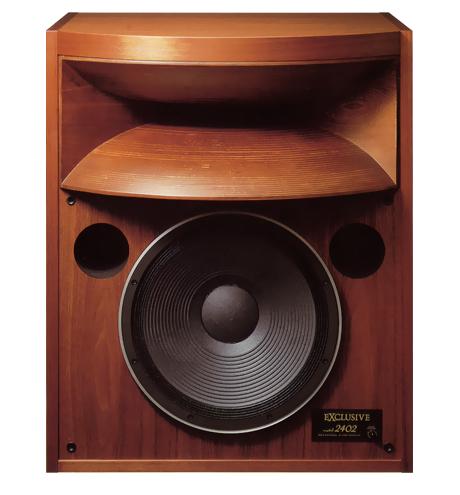
Ususally the 4001 horn/driver combo is operated from >600Hz.
The XO of the TAD 2402 is @ 650Hz.
The Fc of the TH4001 specified per TAD is 320Hz, but according to TAD afficionados the actual Fc is closer to 270Hz.
The Arai 290A is a clone of the 4001 and I think it is safe to refer to Fc=290Hz for the TAD 4001 as well.
Really?! This is the rear chamber tuning for a >600 Hz XO?
GM
To my knowledge there are very few - if any - mass produced "true" OS horns available on the market.
EAW used OS-like round horns for the LA-series, QSC produced the SP-000106-GP, JBL appears to have produced a limited amount of round OS-horns for custom install loudspeakers.
I've also come across OS-like waveguides from China and other Asian countries.
Finally, there's the DDS ENG 1-90 Pro, a copy of a round horn that Mark Engebretson designed for RAMSA. Even though it looks similar, I am not convinced it's a "true" OSWG.
The DDS ENG 1-90 Pro was measured by Joseph Crowe and the plots were posted here.
The results are quite miserable to be honest, which I largely attribute to the mismatch between the waveguide and the TAD TD-2001's deep throat section (aka its "snout"), as well as the WG's moderate size.
The person who built this system obviously wasn't aware of these subtle, albeit important details.
Joseph, it would be interesting to see measurements of the ENG 1-90 Pro with the RCF ND350 and/or the (modified) B&C DE400Tn. At least some improvements are to be expected.
By far the best performing OSWGs are the ones in Geddes' Summa/NS-15 and those designed by mabat.
EAW used OS-like round horns for the LA-series, QSC produced the SP-000106-GP, JBL appears to have produced a limited amount of round OS-horns for custom install loudspeakers.
I've also come across OS-like waveguides from China and other Asian countries.
Finally, there's the DDS ENG 1-90 Pro, a copy of a round horn that Mark Engebretson designed for RAMSA. Even though it looks similar, I am not convinced it's a "true" OSWG.
The DDS ENG 1-90 Pro was measured by Joseph Crowe and the plots were posted here.
The results are quite miserable to be honest, which I largely attribute to the mismatch between the waveguide and the TAD TD-2001's deep throat section (aka its "snout"), as well as the WG's moderate size.
The person who built this system obviously wasn't aware of these subtle, albeit important details.
Joseph, it would be interesting to see measurements of the ENG 1-90 Pro with the RCF ND350 and/or the (modified) B&C DE400Tn. At least some improvements are to be expected.
By far the best performing OSWGs are the ones in Geddes' Summa/NS-15 and those designed by mabat.
Attachments
That said, the sims of the docali's drba_swh_160_sq_pe_rb posted by DonVK look very promising. Thanks to both docali and Don for your efforts!
It would be interesting to see sims of an even shorter horn (T factor 5??).
It would be interesting to see sims of an even shorter horn (T factor 5??).
Last edited:
The Fc of the TH4001 specified per TAD is 320Hz, but according to TAD afficionados the actual Fc is closer to 270Hz.
The Arai 290A is a clone of the 4001 and I think it is safe to refer to Fc=290Hz for the TAD 4001 as well.
This is not what i recall about this combo, number i remember are an octave higher.
The one i've seen/ heard ( including clone) were crossed from 480hz ( Kinoshita's own evolution of the design used in MTM in wall) up to 640 hz ( in Tad/ Pionneer exclusive way).
In practice 480hz is already pushing the limit to optimum wrt this horn/cd combo and need steep filters.
Fc is 320Hz according to TAD.
TN-3 interface network for bi-amping is specified for 600-800Hz.
Fc is the cut off frequency of the horn. The recommended crossover point for the driver + horn is usually at least one octave above Fc.
TN-3 interface network for bi-amping is specified for 600-800Hz.
Fc is the cut off frequency of the horn. The recommended crossover point for the driver + horn is usually at least one octave above Fc.
Attachments
Last edited:
Your obviously right about spec Ro808.
My point was about usable freq range: really lower than 480hz is the edge of compromise for my preference.
Might be working with FIR steep filter but if you want lower you'll need a different design for the horn at least.
600/800hz is 'typical' for passive design using the TH 4001 or equivalent. Works well but you'll put demands on woofer and from my experience this shift the demanding parts to them. Compromise as always.
My point was about usable freq range: really lower than 480hz is the edge of compromise for my preference.
Might be working with FIR steep filter but if you want lower you'll need a different design for the horn at least.
600/800hz is 'typical' for passive design using the TH 4001 or equivalent. Works well but you'll put demands on woofer and from my experience this shift the demanding parts to them. Compromise as always.
Indeed and moreover, you don't want to run the unhealthy and expensive risk of blowing a TAD diaphragm 😉
Quote by djk:
"Different horn manufacturers have different specifications for their products.
The lowest recommended crossover point depends on the combination of the horn, driver, and the slope of the crossover.
An EV HR90 is recommended to cross over at 800hz/12dB, but the horn actually has a similar Q at 500hz as an Altec 311-90 that is rated at 300hz/12dB (the Q giving an idea of the driver loading at any given frequency).
Could we cross an HR90 over lower than 800hz, and if so, how much lower?
Based on the depth of the horn (13.8") the 1/4W cut-off point would be about 245hz. This horn should be fine with a LR24 at 500hz and a metal diaphragm driver. It should be fine at 500hz with a phenolic driver at 6dB. It should be fine at 500hz with a plastic-edged metal diaphragm at 12dB."
"Different horn manufacturers have different specifications for their products.
The lowest recommended crossover point depends on the combination of the horn, driver, and the slope of the crossover.
An EV HR90 is recommended to cross over at 800hz/12dB, but the horn actually has a similar Q at 500hz as an Altec 311-90 that is rated at 300hz/12dB (the Q giving an idea of the driver loading at any given frequency).
Could we cross an HR90 over lower than 800hz, and if so, how much lower?
Based on the depth of the horn (13.8") the 1/4W cut-off point would be about 245hz. This horn should be fine with a LR24 at 500hz and a metal diaphragm driver. It should be fine at 500hz with a phenolic driver at 6dB. It should be fine at 500hz with a plastic-edged metal diaphragm at 12dB."
EV HR6040 or 9040 can go very low.
Minimum crossover frequ. 400 Hz
https://www.electrovoice.com/binary/HR9040A EDS.pdf
Minimum crossover frequ. 400 Hz
https://www.electrovoice.com/binary/HR9040A EDS.pdf
- Home
- Loudspeakers
- Multi-Way
- Is it possible to cover the whole spectrum, high SPL, low distortion with a 2-way?
